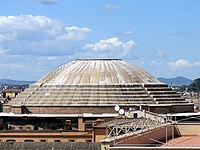
Photo from wikipedia
Over the last few years, many studies were performed to investigate rubberized concrete’s behavior as a sustainable alternative for conventional concrete by replacing natural aggregates with recycling old rubber tires.… Click to show full abstract
Over the last few years, many studies were performed to investigate rubberized concrete’s behavior as a sustainable alternative for conventional concrete by replacing natural aggregates with recycling old rubber tires. These studies have shown that the concrete's mechanical and durability properties are significantly reduced, while its ductility and damping ratio improved. Accordingly, using this material in RC structures could be a promising solution for improving their energy dissipation capabilities. Currently, the literature lacks a numerical study that can highlight the effectiveness of using high-strength rubberized concrete for retrofitting RC structures subject to earthquake loadings . Therefore, this research investigates the seismic performance of reinforced concrete buildings strengthened using different high-strength rubberized concrete mixtures under various ground motion excitations. As a part of the study, finite element models of reinforced concrete structure retrofitted with these concrete mixes will be analyzed using nonlinear response history analysis and compared against two different control models composed of a bare structure and a jacketed RC structure using the control concrete mixture. In general, using rubberized concrete jacketing improved the seismic performance of the bare structure significantly. Furthermore, utilizing high-strength rubberized concrete rather than the control one resulted in increasing the damping energy and slightly reducing the base shear forces of the structure.
Journal Title: Arabian Journal for Science and Engineering
Year Published: 2021
Link to full text (if available)
Share on Social Media: Sign Up to like & get
recommendations!